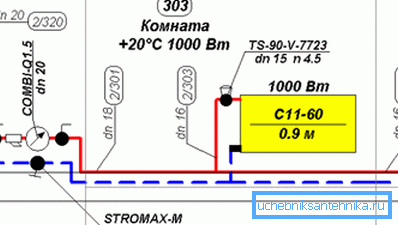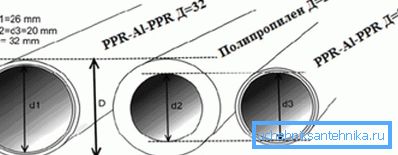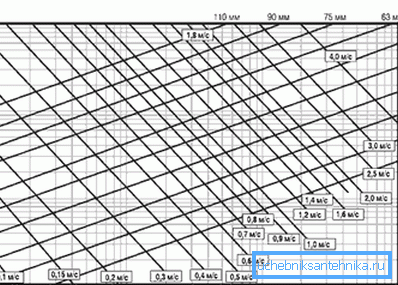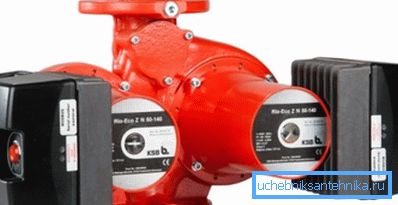Hydraulic calculation of the heating system: just about
What is a hydraulic calculation of a heating system? What values need calculations? Finally, the main thing: how to calculate them, without having the exact values of hydraulic resistance of all sections, heating devices and elements of valves? Let's figure it out.

What we expect
For any heating system, the most important parameter is its heat output.
It is determined by:
- Coolant temperature.
- Thermal power of heating devices.
Note: in the documentation, the last parameter is indicated for a fixed delta of temperatures between the temperature of the coolant and air in a heated room at 70 C. Reducing the delta of temperatures by half will result in a twofold decrease in thermal power.
We will leave the methods for calculating heat output behind the scenes: they have enough subject materials devoted to them.
However, in order to ensure the transfer of heat from the highway or boiler to heating devices, two more parameters are important:
- The internal section of the pipeline, tied to its diameter.

- The flow rate in this pipeline.
In an autonomous heating system with forced circulation, it is important to know a couple more values:
- Contour hydraulic resistance. The calculation of the hydraulic resistance of the heating system will determine the requirements for the pressure generated by the circulation pump.
- The flow rate of the coolant through the circuit, determined by the performance of the circulation pump of the heating system with an appropriate head.
Problems
As they say in Odessa, "they are."
In order to calculate the total hydraulic resistance of the circuit, you need to consider:
- Resistance of straight pipe sections. It is determined by their material, internal diameter, flow rate and the degree of wall roughness.

- Resistance of every turn and diameter transition.
- Resistance of each valve element.
- Resistance of all heating devices.
- Boiler heat exchanger resistance.
Collecting all the necessary data together will clearly become a problem even in the simplest scheme.
What to do?
Formulas
Fortunately, for an autonomous heating system, the hydraulic calculation of heating can be carried out with acceptable accuracy and without going into the wilds.
Flow rate
From the bottom side it is limited by the growth of the temperature difference between the flow and return, and at the same time, the increased probability of airing. Rapid flow will force air from the bridges to the automatic air vent; the slow one cannot cope with this task.
On the other hand, too fast a flow will inevitably generate hydraulic noise. Elements of valves and turns of bottling will be a source of annoying hum.

For heating, the range of acceptable flow rates is from 0.6 to 1.5 m / s; however, the calculation of other parameters is usually performed for a value of 1 m / s.
Diameter
With the known thermal power it is easiest to pick it up according to the table.
| Internal diameter of pipe, mm | Heat flux, W at Dt = 20С | ||
| Speed 0.6 m / s | Speed 0.8 m / s | Speed 1 m / s | |
| eight | 2453 | 3270 | 4088 |
| ten | 3832 | 5109 | 6387 |
| 12 | 5518 | 7358 | 9197 |
| 15 | 8622 | 11496 | 14370 |
| 20 | 15328 | 20438 | 25547 |
| 25 | 23950 | 31934 | 39917 |
| 32 | 39240 | 52320 | 65401 |
| 40 | 61313 | 81751 | 102188 |
| 50 | 95802 | 127735 | 168669 |
Head pressure
In a simplified version, it is calculated by the formula H = (R * I * Z) / 10000.
In it:
- H is the desired head value in meters.
- I - pressure loss in the pipe, Pa / m. For a straight pipe section of the calculated diameter, it takes a value in the range of 100-150.
- Z is an additional compensation factor, which depends on the availability of additional equipment in the circuit.
| Contour elements | Coefficient value |
| Fittings and Fittings | 1,3 |
| Thermostatic heads and valves | 1.7 |
| Mixer with three or two-way valve | 1.2 |

If the system contains several elements from the list, the corresponding coefficients are multiplied. So, for a system with ball valves, threaded fittings for pipes and a thermostat that regulates the permeability of bottling, Z = 1.3 * 1.7 = 2.21.
Performance
Instructions for calculating with your own hands the performance of the pump is also not difficult.
Productivity is calculated by the formula G = Q / (1.163 * Dt), in which:
- G - performance in m3 / hour.
- Q is the thermal power of the circuit in kilowatts.
- Dt is the temperature difference between the supply and return lines.
Example
Let's give an example of the hydraulic calculation of the heating system for the following conditions:
- The delta temperature between the supply and return pipes is equal to the standard 20 degrees.
- Thermal power of a copper - 16 KW.
- The total length of the single-pipe Leningradka bottling is 50 meters. Heating devices are connected in parallel with bottling. Thermostats, breaking the filling, and secondary circuits with mixers are missing.
So let's get started.
The minimum internal diameter according to the table above is 20 millimeters at a flow velocity of at least 0.8 m / s.
Useful: modern circulation pumps often have a stepped or, more conveniently, a smooth adjustment of performance. In the latter case, the price of the device is somewhat higher.

The optimal head for our case will be (50 * 150 + 1.3) / 10000 = 0.975 m. Actually, in most cases the parameter does not need to be calculated. The difference in the heating system of an apartment building, which provides circulation in it - only 2 meters; this is exactly the minimum head value of the absolute majority of wet-rotor pumps.
Productivity is calculated as G = 16 / (1.163 * 20) = 0.69 m3 / hour.
Conclusion
We hope that the above calculation methods will help the reader to calculate the parameters of his own heating system, without getting into the jungle of complex formulas and reference data. As always, the attached video will offer additional information. Successes!